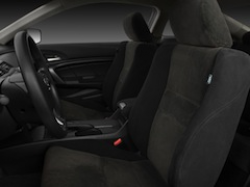
— Purchasing a new car means a test drive to find out how well the car runs, and for some people, a time to imagine how great they will look in the car.
For many of us, a test drive means a few trips around the block with a salesperson sitting in the passenger seat trying to tell us the great benefits of the car.
It's those short test drives that can come back to haunt you, something certain Honda Accord drivers know all too well.
Long-time drivers describe the Accord as having the most uncomfortable driver seat in the world.
The complaints started with the 2008 Accord and have continued to the 2012 model year. On CarComplaints.com, it's the top complaint for 2010, 2011, and 2012 models.
Complaints submitted to CarComplaints.com, the National Highway Traffic Safety Adminstration, and The Center for Auto Safety show a pattern of Accord owners complaining the seat causes leg pain and numbness, back pain, neck pain, basically just a royal pain all the way around.
Drivers say that even on short trips, they experience severe back pain and numbness in their legs to the point of it being a serious distraction.
Owners report losing thousands of dollars after trading in their cars just a few weeks after buying them. Furthermore, for those who keep their car, many say they absolutely dread the thought of driving it.
Considering a car owner could complain about hundreds of different problems in a vehicle, what makes the Accord seat such a complaint magnet?
You'll have an idea after reading a few quotes from complaints:
"Why did they add a brick for lumbar support!"
"The lumbar area, although adjusted completely down, feels like someone is sticking a knee in your back."
"The headrest puts your head forward while the bottom of the seat forces your lower back into the concrete block Honda used as a lumbar support."
Granted, anyone could have a specific body type that would make certain seats a pain in the neck, but Accord complaints come from people of all sizes, shapes, and ages.
"It really sucks to be sitting in a new car with all sorts of excellent features and that is driving well and be in so much pain and discomfort that you want to get rid of it," said Will, of Spartanburg, South Carolina. "I was such a Honda die-hard before this."
Out of desperation, Will did what others have done. He went to his Honda dealer in search of a solution.
"My dealership, for their part, seemed genuinely concerned and caring, but also powerless as their regional sales manager has no solution," Will said.
Although Honda has heard these complaints for at least 4 years, Accord owners shouldn't expect a recall or any other government intervention.
"We are never happy to hear when we learn that a customer is dissatisfied with one of our products," said Chris Naughton, of the office of Honda public relations. "As with so many aspects of all automobiles, ergonomics, seat construction and shape, etc. are designed with the intent of being comfortable and appropriate for as many people as possible."
Mr. Naughton said the vast majority of customers find the seats in Honda vehicles comfortable and it wouldn't be practical to retroactively retrofit or redesign a portion of a seat.
"It is our hope that this issue remains a very rare occurrence," Naughton said.
So what can you do when a seat is destroying your body?
Accord owners report some relief after custom-made seat covers were installed. Other drivers have returned their new car after only a few hundred miles, all at a severe blow to their wallets.
Still others, such as Peter, of New York, got rid of the car but at least kept it in the family.
"I bought a 2012 Honda Accord less than 1 week ago. Within 2 days, I started to have significant lower back pain," Peter said. "The headrest pushes your head forward and you can't adjust the seat to take pressure off your spine."
Peter's solution? He traded his brand new car to his son in exchange for a 2005 Jeep Cherokee.
Short of trading in your car or ripping the seat out, the best thing you can do to avoid problems is to know how your body should fit in a seat, even on a short test drive.
Dr. Scott Bautch, ergonomics expert at the American Chiropractic Association, offers the following tips.
1. The back of the seat should be close to vertical which encourages a sitting posture where the ear is over the shoulder, and the shoulder is over the hip.
2. The steering wheel should be close enough so the arms can be comfortably flexed.
3. The head should be no more than 1 to 2 inches off the headrest and ideally against the headrest, to minimize possible damage from a rear-end collision.
4. The knees should be in a position above the hips and back at an angle that will keep the ankles comfortable.
Dr. Bautch said that poor posture is not only damaging to the spine, especially from road vibration, but it also increases fatigue and mental sluggishness.
Studies indicate poor posture increases the development of both fatigue and drowsiness, two problems no driver needs.




